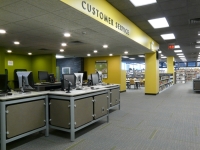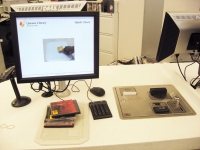Deploying Self Service Technology to 62 Libraries
Queens Public Library, N.Y.
Innovation Synopsis
Queens Library staff performed 75 million manual check-in and check out operations a year plus 2 million small cash transactions in 62 libraries ranging from antique Carnegies to cutting edge modern. They installed self-service kiosks including 24/7 check-ins using a semi-standardized model.
Challenge/Opportunity
As one of the busiest libraries, Queens Library was a victim of its own success. By 2004, more than 75 million manual actions per year were required for check in/out and 2 million cash transactions were required to collect fees (most for small amounts). The library wanted to switch to self-service equipment, including self-service payments, but the software was not commercially available. Customers in Queens speak dozens of languages, so developing a system that was obvious and intuitive across cultures was a challenge. Following a successful pilot in 2005, deployment began systemwide. Each library building is different in design, age and ambience; while the concept of installing “historically correct” computers in a Carnegie is ridiculous, Queens Library at least wanted to be sensitive to aesthetics. We also wanted automated sorting of returns, which requires square footage, always in short supply. On the staff-facing side, self-checks had to be easy to maintain and operate and the ability to run it from a standard PC versus a specialized unit was preferred, to keep costs down and allow for easy upgrades going forward.
Key Elements of Innovation
Working with technology partners, Queens Library developed the first self-service check out software that also allowed customers to pay fines and fees at the check-out without staff mediation. The nexus is an RFID tag placed in each library item to be circulated and another in the library card. The software communicates with the library’s central cardholder database, and also with the accounting systems. User interfaces are graphically driven. They include how-to video. Screens can be programmed in any language and easily customized to the needs of the library location. To install in so many different buildings, the library developed standardized housing furniture. The counter top is solid surface polymer to avoid interference from metal surfaces. As many units as desired are placed in a stepped arrangement to give each customer privacy and permit wheelchair access, with the plasma screen on an articulating arm for adjustment to any height. The fronts are paneled to blend in with any décor. Check-in units are placed so they back on a small workroom with self-sorting equipment. There are between 3 and 21 sorting bins, depending on the volume each library does. As an item is returned, it is checked back in against the customer’s account, a receipt is issued, and it is sorted for quickest re-shelving. Because installation requires changes to the circulation desk, the installations were timed to coincide with other needed capital work in the libraries along with new flooring, lighting and some décor upgrades. It minimized disruptions in service and gives a visual cue to customers that something new and wonderful has happened in their library.
Achieved Outcomes
All Queens Library locations have RFID-powered check in and check out. Full self-service capability, including 24/7 check in access, is available in more than half of the locations. Queens Library has the world’s largest library deployment of self-sorting equipment, and once installed, it operates at a nominal cost because it takes up so little room and is low maintenance. Self-service technology saves a tremendous amount of staff time. It allows the same number of employees to turn their attention to ever-increasing and higher-value customer service interactions. In every library where self-payment has been installed, cash transactions with staff have been almost completely eliminated, along with all the attendant security issues. Additionally, customers are more likely to pay fees when prompted anonymously by the kiosk. Staff deal with many fewer indignant customers. Self-check in is completely accurate. Staff are freed from time spent struggling with customers who say they returned an item but the records say they still have it. More than 350 additional service touch-points have been created that will serve as marketing opportunities and opportunities to engage customers in other library programs or services.


